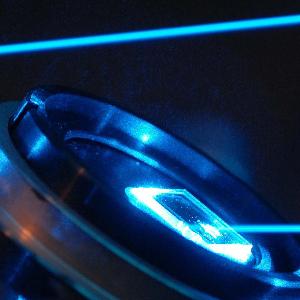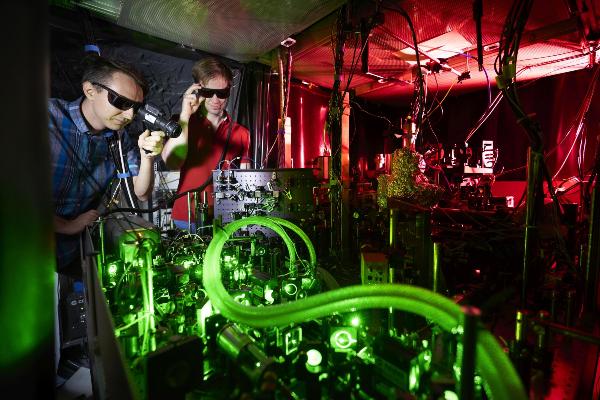
Laser Optics and Quantum Optics
We investigate the structure of atoms and molecules with highest precision in order to find possible limits of existing physical laws.
In the field of quantum science and quantum technology we also work on the development of quantum simulators and quantum computers and on absolutely safe transmission possibilities by means of quantum communication.

Using experiments in quantum optics, we investigate the interaction between light and matter. The laser has proven to be the ideal light source for this purpose, as it is extremely monochromatic and coherent. The laser enables us to perform high-resolution spectroscopy of individual atoms and ions, or even of antimatter. We observe the interaction of ultracold atoms in light crystals and build artificial solids that we can control very precisely at temperatures only a few millionths of a Kelvin above absolute zero. This allows us to study the behaviour of matter under the most extreme conditions in controlled laboratory conditions to find out how materials obtain their properties such as electrical conduction, magnetism, etc. On the attosecond time scale we investigate the movement of single electrons within atoms in real time. We follow what happens to elementary particles after excitation. This allows us to explore the basic processes of life and the ultimate limits of electron-based signal processing in light controlled electronics. Another focus is on the development of future-oriented laser technologies for use in medicine, biology and materials science. In our research group, we also developed infrared spectroscopy laser technologies. This enables us to explore the molecular composition of blood in order to detect cancer at an early stage. In the course of new technological developments, light sources have become available that allow to test the dynamics of the QED quantum vacuum. One focus of laser physics and quantum optics is therefore the theoretical investigation of the nonlinear properties of the quantum vacuum in ultra-intensive laser light. The theoretical foundations include relativistic quantum many-particle systems and relativistic quantum transport. Due to the required high accuracy, the numerical methods for solving the corresponding equations have to abandon the established approaches in relativistic classical plasma physics, e.g. by applying newer KI methods. The investigation of ultra-intensive laser light in a vacuum is at the beginning of an exciting scientific and technological development.
Professors
Prof. Dr. Monika Aidelsburger
Ultracold Bosons in Optical Superlattices / Ultracold Fermions in Optical Lattices / A Caesium Quantum Gas Microscope / Ultracold Atoms in a honeycomb optical lattice
Prof. Dr. Immanuel Bloch
Quantum Optics / Quantum Simulations / Quantum Computing / Experiments on Fundamental Aspects of Quantum Physics / Ultracold Atomic and Molecular Quantum Gases
Prof. Dr. Theodor W. Hänsch
Bose-Einstein condensation / Fermionic quantum gases / Frequency comb
Prof. Dr. Peter Hommelhoff
Laser Physics / Quantum, electron, and nano optics / Attosecond Physics / Plasmonics and Solid State Physics
Prof. Dr. Stefan Karsch
Development of High-Field Lasers / Relativistic laser interaction with plasmas / Laser driven plasma accelerator, hybrid laser plasma accelerator
Prof. Dr. Ulf Kleineberg
Multilayer x-ray optics for attosecond pulses / EUV Lithography / Time-resolved photoemission microscopy
Prof. Dr. Matthias Kling
Attosecond spectroscopy of molecules and nanoscale solids / Controlling and imaging ultrafast molecular dynamics / Interaction of strong, ultrashort fields with clusters & nanomaterials
Prof. Dr. Ferenc Krausz
High-intensity ultra-short light wave synthesis / Attosecond x-ray pulses and spectroscopy / Particle acceleration with light
Prof. Dr. Eberhard Riedle
Examining the temporal behavior of optical switch molecules / Femtochemistry: explaining re-action mechanisms in molecules / Generation & characterization of the shortest tunable light pulses
Prof. Dr. Hartmut Ruhl
Physics of strong laser fields and the dynamics of the nonlinear quantum vacuum of the QED / Relativistic quantum multiplicity particle systems and relativistic quantum transport theory / Adaptive numerical methods and modern methods of artificial intelligence (AI) in numerics
Prof. Dr. Jörg Schreiber
High intensity laser plasma interactions / Laser driven particle acceleration, e.g. at the Center for Advanced Laser Applications (CALA) / Multimodal radiotherapy with ultrashort ion bunches
Prof. Dr. Harald Weinfurter
Experiments on the foundations of quantum physics / Quantum communication and quantum teleportation with correlating photons / Quantum cryptography
Prof. Dr. Johannes Zeiher
Quantum Computing with Neutral Atoms / Rydberg Atoms in Optical Lattices / Quantum Gas Microscopy of Many Body Systems / Quantum Matter Interfaces/Quantum Networks
Quantum cryptography
3 | 2 Mar 2023

